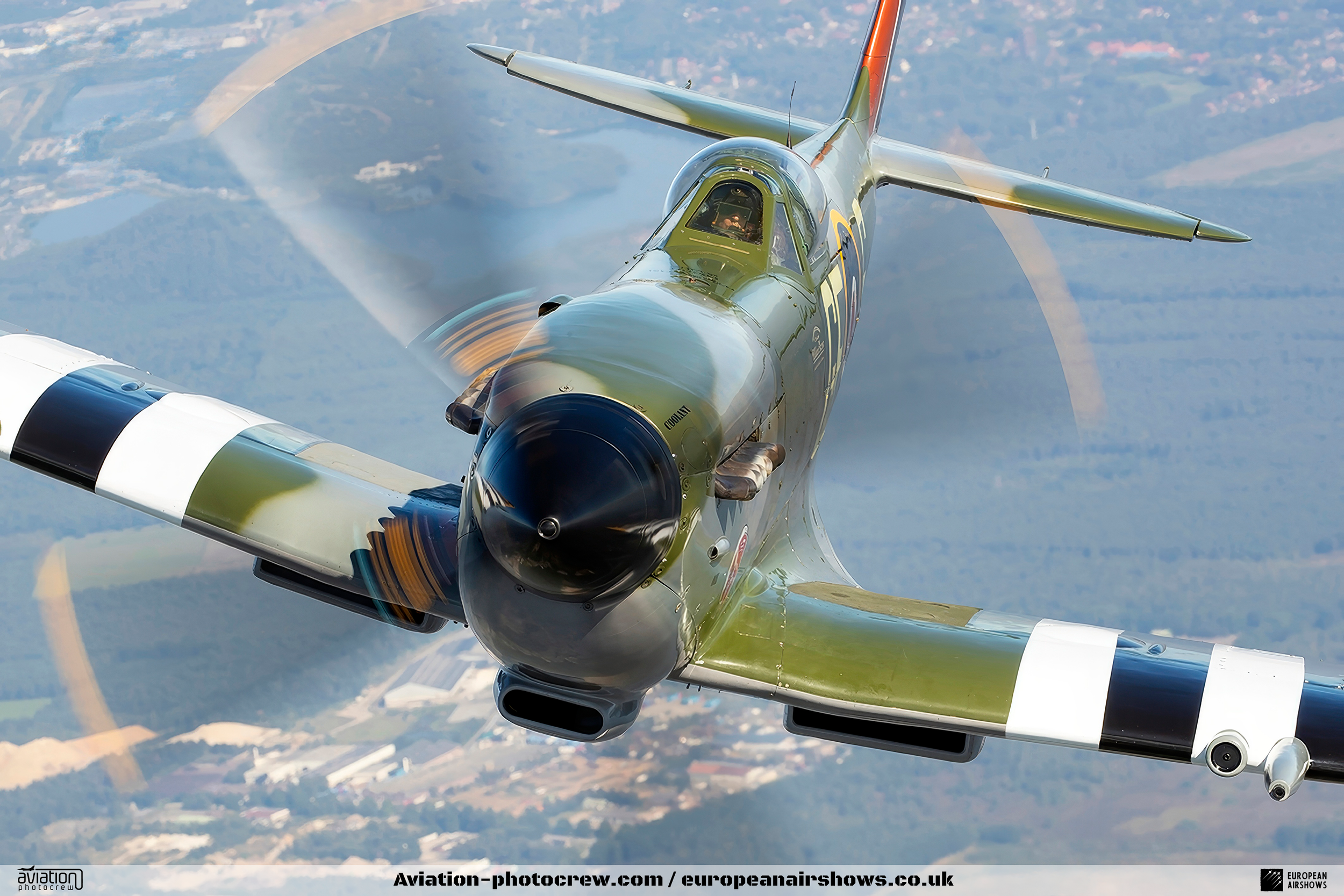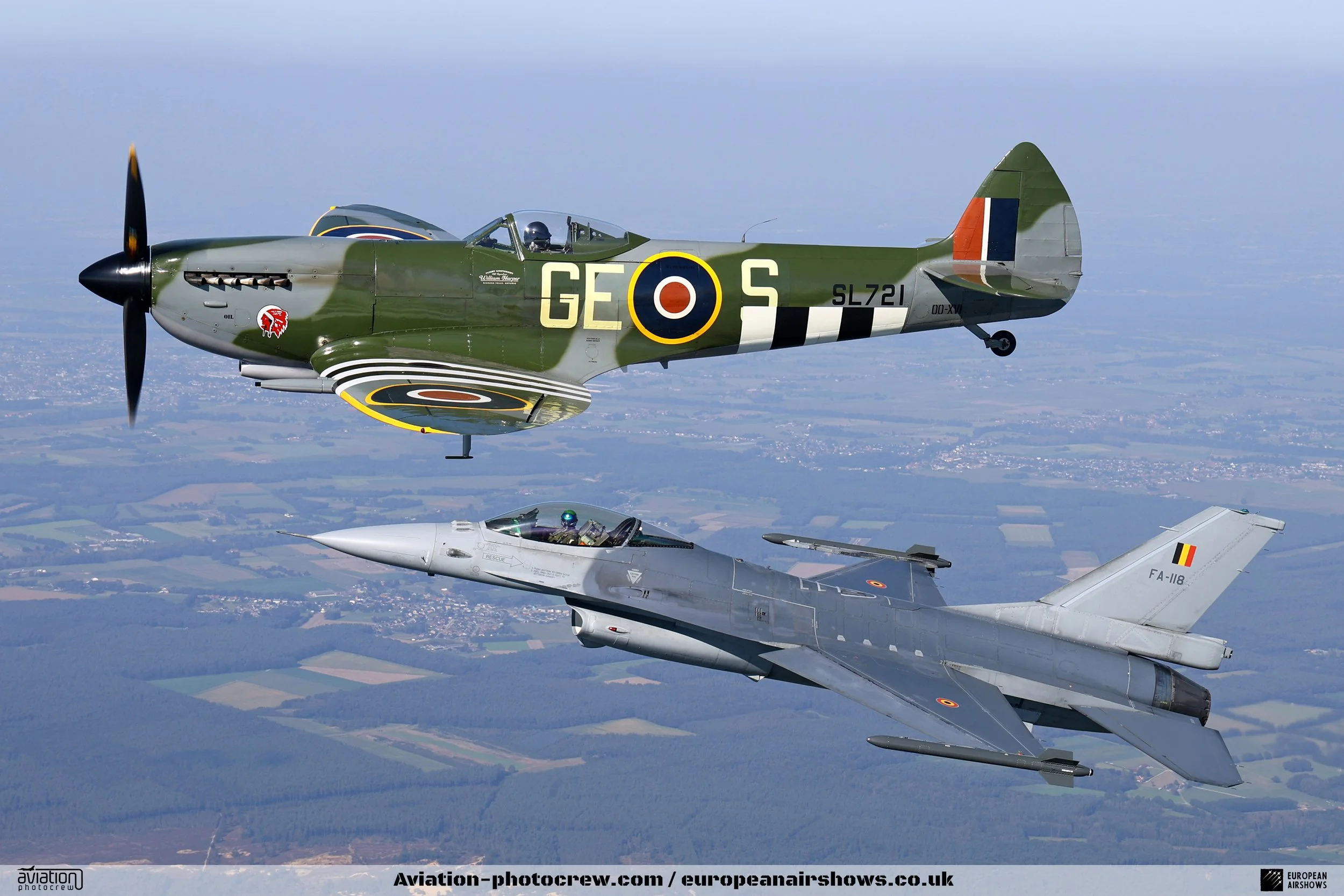
Supermarine Spitfire LF.XVI OO-XVI
About the Spitfire
The Supermarine Spitfire first took to the air in the mid‑1930s and quickly became an icon of British aviation. Designed by Reginald Mitchell for the Royal Air Force, its distinctive elliptical wing and innovative stressed‑skin construction enabled exceptional speed and maneuverability. From early prototypes to successive “marks” that introduced improved armament, stronger structures, and more powerful Rolls‑Royce Merlin engines (and later Griffon engines), the Spitfire was continuously refined to meet the changing demands of aerial combat during World War II. Its elegant design and high performance made it a symbol of determination and hope during Britain’s darkest hours.
Throughout its operational history, the Spitfire evolved from a sleek, single‑seat interceptor into a multifaceted workhorse. Early versions faced significant production challenges with rapid modifications—ranging from upgrades in cockpit design to re‑armament changes driven by combat experience. The aircraft played a decisive role in the Battle of Britain and later proved adaptable as a fighter‑bomber, a high‑altitude interceptor, and even as a carrier‑based fighter (in the Seafire variant). By the end of the war, more than 20,000 Spitfires of various marks had been built, a testament to its versatility and the industry-wide efforts that supported its production.
Even as World War II drew to a close, the Spitfire’s development continued with further modifications to improve high‑altitude performance, extend range with increased fuel capacity, and enhance pilot visibility. The transition from Merlin to Griffon engines ushered in a new era of performance that allowed the aircraft to remain competitive against evolving enemy designs. Long celebrated after the war as a masterpiece of aeronautical engineering, the Spitfire is now an enduring symbol of British ingenuity, frequently appearing in museums and airshows, where it continues to captivate aviation enthusiasts around the world.
Specifications
Crew
1
Length
31 ft 6 in (9.47 m)
Wingspan
37 ft (11.23 m)
Height
13 ft 9 in (4.25 m)
Max Speed
403 mph (650 km/h, 350 kn)
Range
429 mi (692 km, 373 nmi)
Service Ceiling
42,500 ft (12,954 m)
Rate of climb
4,745 ft/min (24 m/s)
LF.XVI Variant
The Mk. XVI LF Spitfire was a low‐altitude fighter variant of the famous Supermarine Spitfire family that emerged late in World War II. Distinguished by its powerful, license‐built Rolls–Royce Merlin 266 engine (the Merlin 66 produced in the United States by the Packard Motor Company, with the “2” prefix added to avoid confusion with its British counterpart), the Mk. XVI was developed essentially on the proven airframe of the earlier Mk. IX but optimized for operations at lower altitudes.
In order to maximize performance where rapid acceleration and tight manoeuvring were required, virtually all Mk. XVI aircraft were fitted with clipped wings. This modification not only reduced drag at low altitude but also enhanced roll rate and overall agility. In addition, many examples featured a cut‐down rear fuselage paired with a bubble canopy that improved pilot visibility during close combat engagements. Rear fuselage fuel tanks with a combined capacity of approximately 75 imperial gallons were standard, reflecting the variant’s design emphasis on the short-range, high-intensity fighter role rather than long-range patrol.
Armament on the Mk. XVI was typically a mix of heavy firepower and precision: two 20 mm Hispano Mark II cannons (each loaded with around 120 rounds per gun) formed the core of its offensive capability, supplemented by two .50‑calibre Browning machine guns (each with 250 rounds per gun). The variant could also be configured to carry small bombs—a 500‑lb bomb on a centerline rack and optionally additional 250‑lb bombs under the wings—for use in fighter-bomber roles.
Produced at the Castle Bromwich factory, a total of approximately 1,054 Mk. XVI units were manufactured. Their performance at low altitude was exceptional; the combination of the Packard Merlin engine and aerodynamic refinements allowed this variant to exhibit superb acceleration and turning ability during combat—qualities that were crucial when countering fast, low-flying enemy aircraft.
Did You Know?
- The destruction of Supermarine’s Itchen and Woolston factories by enemy bombing led to production being shifted to numerous “shadow factories”—with Castle Bromwich becoming the main hub for Spitfire manufacturing.
- Early Spitfires were famous for their elegant, elliptical wing design, chosen not only for its low induced drag but also for its aesthetic appeal—a design feature that helped to capture the public’s imagination.
- The Spitfire Mk IX was actually developed as a “stopgap” measure in response to the Focke‐Wulf Fw 190 threat and was produced from converted Mk Vc airframes before later high‐altitude models appeared.
- Some Spitfire variants were adapted for photo reconnaissance. For example, the PR Mk XIX became the definitive reconnaissance version with increased fuel capacity and specialized camera installations.
- Engine changes sometimes required more than simply swapping powerplants—the installation of the Griffon engine, for instance, necessitated modifications to the cowling, tail, and undercarriage to cope with its different thrust line and increased weight.
Test Your Knowledge
Spitfire LF.XVI OO-XVI
SL721 began its life as a Spitfire Mk XVI, rolling off the production line in August 1945 and heading for a quiet start at the 6 Maintenance Unit. After a few months of storage, the aircraft entered active service in 1946 when it was delivered to the Fighter Command Communications Squadron. Soon after, it found a second home with the Metropolitan Communications Squadron, where it became the personal aircraft of Air Chief Marshal Sir James Milne Robb. The Spitfire was given the distinctive J-MR codes and painted in a special light blue, marking its association with the esteemed officer.
In 1949, Sir James Milne Robb, who had moved on to another command, reclaimed his beloved aircraft from the Maintenance Unit. The plane’s journey from military service to the private sector began in 1954 when SL721 was sold to new owners and taken to the Beaulieu Motor Museum, where it found a curious resting place on a garage forecourt. The 1960s saw the aircraft enter the collection of early warbird restorer Doug Arnold. Although Arnold’s acquisition did not immediately lead to restoration work, SL721 was moved indoors for the first time in its life—an important improvement over its previous exposure to the elements.
The early 1970s marked another new chapter as Doug Arnold sold the Spitfire to American collector Bill Ross from Chicago. Ross restored the aircraft and repainted it in the classic Battle of Britain colors, complete with the initials JMR. In 1977, the aircraft changed hands again when it was sold to Woodson K. Woods. Under Woods’ stewardship, SL721 was rebuilt and featured a new look in RAF camouflage adorned with Woodson’s own initials, WKW.
In 1999, a return to form occurred when Chris Woods, son of Woodson, restored SL721 to its 1949 appearance as flown by Air Vice-Marshal Sir James M. Robb, retaining the famous light blue scheme and JMR initials. A few months later, in 2000, Michael Potter of Ottawa purchased the aircraft. Three years on, Potter consulted Spitfire historian Bob Swaddling for a fresh new look. Drawing on Bob’s detailed research, the Spitfire was repainted to emulate No. 421 Squadron Royal Canadian Air Force’s camouflage, adopting the code AU*J. This paint scheme honored Flight-Lt. William Harper of Niagara Falls, Ontario, who flew the first Canadian Mk XVI bubble canopy Spitfire into action and had long wished for the distinctive McColl’Frontenac oil Company Indian head emblem—a logo that came to symbolize the squadron’s Spitfires.
The globe-trotting history of SL721 continued in 2018 when it was sold to Mr. Kris Van Den Bergh in Belgium. The Spitfire was reassembled at the FAST Aero Workshop in Brasschaat and, on May 6th, 2018, made aviation history by becoming the first Spitfire registered in Belgium in over fifty years and the very first to depart from Brasschaat Aerodrome.






